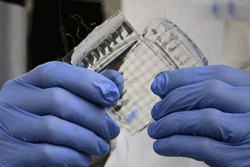Breakthrough technology is remarkably stretchable and displays superior sensitivity
Researchers at Stanford University have successfully developed a stretchy, transparent, skin-like sensor which can be used in such applications as prosthetic limbs, robotics, and touch-sensitive computer displays. This is exciting news, but the one question that everyone is asking: how’d they do it?

A close-up view of the super-stretchy, transparent, highly sensitive skin-like sensor that Zhenan Bao, associate professor of chemical engineering, and Darren Lipomi, postdoctoral researcher in chemical engineering, developed at Stanford University with their colleagues. (Credit: Steve Fyffe, Stanford News Service.)
First, meet the minds behind the technology
The sensor was developed by Stanford’s Zhenan Bao, an associate professor of chemical engineering, who has long researched the area of developing artificial skin. She, along with Darren Lipomi, a postdoctoral researcher in Bao’s lab, Michael Vosgueritchian, a grad student in chemical engineering, and Benjamin Tee, a grad student in electrical engineering, are the primary co-authors of a paper that fully describes this sensor in the October 23rd online publication of Nature Nanotechnology . Sondra Hellstrom, a grad student in applied physics, Jennifer Lee, an undergrad in chemical engineering, and Courtney Fox, a grad student in chemical engineering, also contributed to the research and are co-authors of the paper.
Not just stretchy, this sensor is super-stretchy
The secret to the sensor is carbon nanotubes. Bao and her team sprayed them in a liquid suspension to create a transparent film on top of a thin layer of stretchy silicone. While being sprayed, the “tubes” land in randomly oriented clumps. The team then stretches the silicone, which pulls the little nano groupings into alignment in the direction of the stretch. When the silicone is released, it goes back to its original dimension, whereupon the nanotubes buckle over into a spring-like position.
Stretching the silicone perpendicularly to the initial stretch allows the rest of the nanotube bundles to align themselves in a second direction. This, in turn, allows for the sensor to be completely stretchable in all directions.
These spring-like mini nanostructures serve as the sensor’s electrodes, and are responsible for measuring force applied to the sensor. And in case you’re wondering, no, the repeated stretching of the sensor does not impact their electrical conductivity all that significantly.
It’s also very sensitive
The sensor features two layers of this nanotube-coated silicone. They are positioned face-to-face with one another, with an easy-to-deform piece of silicone in between.
The setup is similar to that found in a battery: the middle layer of silicone stores the electrical charge. When pressure is applied to the sensor, it compresses, which alters the amount of electrical charge it can store. This change is detected by the spring-like carbon nanotubes within the two films, which are somewhat acting like the positive and negative terminals of the battery. The registered change then allows for the sensor to transmit how much pressure it “feels” is being applied.
The sensor works whether it’s being compressed or extended as it is capable of detecting and reacting to differences in pressure patterns. With compression, the greatest deformation is at the center, with decreasing deformation as you move further away from the center. On the other hand, with extension, deformation is sensed along straight lines between the two grips on either end that are stretching the sensor.
So what’s next?
This isn’t Bao’s first go-round with creating a super-sensor. Previously, she and her team successfully created one that could detect the pressure exerted by a “20 milligram bluebottle fly carcass.” This new sensor isn’t that sensitive, but that was a conscious decision by Bao and her team, as they wanted to instead focus on making it stretchable and transparent.
Bao did note, however, that the previous concept could be applied to this new sensor, save a few minor modifications. Pretty exciting stuff. ■
You can download the entire Nature Nanotechnology article here: www.nature.com/nnano/journal/vaop/ncurrent/full/nnano.2011.184.html
Advertisement
Learn more about Electronic Products Magazine





